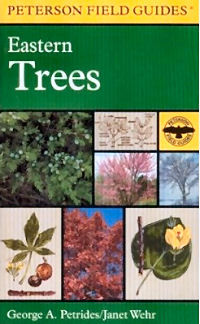 I enjoy reading both fiction and non-fiction, but over the years I've increasingly found myself drawn to non-fiction because I'm a constant learner and I feel that non-fiction feeds this "need" moreso than the average fiction book. With this said, each year I ask for a handful of books for Christmas and one year in particular I really wanted books about trees. I ended up receiving a book from my mom as well as from my husband's parents. The book my mom gave me was Eastern Trees, which is one of the Peterson Field Guides. The other book, the one from Mark's parents, was Dirr's Hardy Trees and Shrubs. This pretty much explains my family: my mom= self-taught botanist and Mark's parents= landscaping outfitters (they coordinate trees from nurseries to go to large landscape projects). While I enjoy both books, I enjoy them for entirely different reasons. Most recently, I've been glued to the Peterson Guide since I've been doing some recon in the local parks and wildlife areas.
I enjoy reading both fiction and non-fiction, but over the years I've increasingly found myself drawn to non-fiction because I'm a constant learner and I feel that non-fiction feeds this "need" moreso than the average fiction book. With this said, each year I ask for a handful of books for Christmas and one year in particular I really wanted books about trees. I ended up receiving a book from my mom as well as from my husband's parents. The book my mom gave me was Eastern Trees, which is one of the Peterson Field Guides. The other book, the one from Mark's parents, was Dirr's Hardy Trees and Shrubs. This pretty much explains my family: my mom= self-taught botanist and Mark's parents= landscaping outfitters (they coordinate trees from nurseries to go to large landscape projects). While I enjoy both books, I enjoy them for entirely different reasons. Most recently, I've been glued to the Peterson Guide since I've been doing some recon in the local parks and wildlife areas.The Peterson Guide to Eastern Trees is wonderful in that it breaks down the trees in the table of contents based on the characteristics of the tree, much like the Newcomb Wildflower Guide, only on a much less complex level. Immediately after this, there are a couple of pages that diagram the main parts of the tree and it explains the differences between needles, leave, leaflets and the various structures of buds. The next section includes a general overview of the overall structure of the trees-- silhouettes. This is particularly helpful for identification from a distance and also for when the leaves are no longer on the trees. After this section, there are charts with the characteristics of the trees and then color drawings on the opposite page to help the reader visually identify the tree by the leaves and the fruit/seeds/nuts. The last main section is the "species accounts" section. This section tells more about the individual species, where they're found, the trees' preferences and their uses for animals and people.
I have found myself particularly drawn to the silhouettes and the quick reference charts and drawings because they're so helpful in identifying the trees while in the field. With this said, I have not been drawn into the species accounts because it feels like it should be part of a separate book since the style is so different. I would probably have been more likely to read these accounts if they were linked in with the charts and drawings for the identification (like Newcomb's Wildflower Guide). As it is though, I've found myself using the Peterson Field Guide whenever I'm away from internet access, but then once I'm home, I can't help but be drawn to the internet's resources to answer my infinite questions about when the trees seed, what they're used for and where they're originally found. While most of this information can be found in the Peterson Guide, I also find that it feels merely surface level and I may be needing something a bit more in depth as my curiosity deepens.

